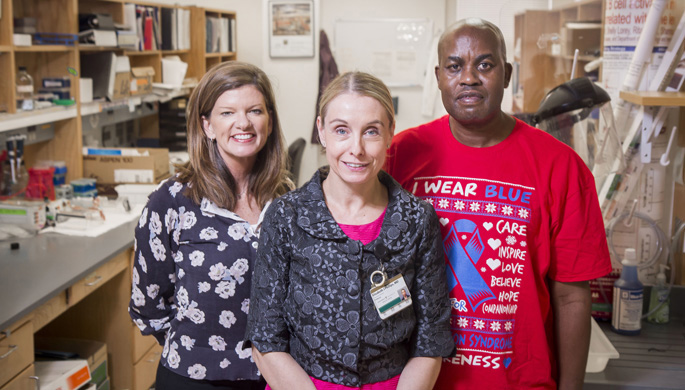
Thirty years ago when she was 16, Katie Niemeyer was prescribed carbamazepine for depression. Three weeks later she was in a St. Louis, Missouri, burn unit with second and third degree burns all over her body. “My parents were told the chances of me surviving were slim,” she said.
In 2009 Douglas Oboh was prescribed allopurinol to treat a painful case of gout in his right big toe. He ended up in the burn unit at Vanderbilt University Medical Center. Nine years later he is still taking medication for the pain. “My body is on fire,” he said.
Niemeyer and Oboh were diagnosed with Stevens-Johnson Syndrome/toxic epidermal necrolysis (SJS/TEN), a potentially fatal immune-mediated adverse drug reaction (ADR) that can sweep through the body like wildfire, blistering the skin and internal mucous membranes. Long-term complications can include vision loss, lung damage and chronic pain.
Recently Niemeyer and Oboh visited the laboratory of Elizabeth Phillips, MD, an internationally known expert on severe ADRs at VUMC, to discuss ways they can help raise awareness and increase support for research aimed at preventing SJS/TEN.
Phillips, professor of Medicine, Pharmacology and of Pathology, Microbiology and Immunology at Vanderbilt, holds the John A. Oates Chair in Clinical Research and is director of Personalized Immunology in the Oates Institute for Experimental Therapeutics.
“We’ve seen a lot of advances in (identifying) genetic predispositions to SJS and this has fueled successful screening efforts,” she said. “But there are still a lot of big gaps.”
It is known, for example, that a specific allele (alternative form) of an HLA gene increases the risk of SJS/TEN in people in Southeast Asia who take carbamazepine.
HLAs, human leukocyte antigens, are several different classes of proteins expressed on the surfaces of cells that, like nametags, help the immune system distinguish “self” — body tissues — from “non-self” — invading pathogens.
Screening for the HLA-B*15:02 allele prior to carbamazepine prescription has now become routine in many Southeast Asian countries, and there has been a remarkable reduction in the incidence of carbamazepine associated SJS/TEN. The same type of preventive screening is also being considered for another allele, HLA-B*58:01, prior to allopurinol prescription.
However, neither Niemeyer nor Oboh carry this allele or any other genetic variations that have been linked to an increased risk for carbamazepine and allopurinol SJS/TEN in studies of Southeast Asian populations.
“We need intense study of diverse populations,” Phillips said, “because there may be different genes in African, European and Hispanic populations prevalent in the United States and internationally that we have yet to discover.
“It’s that knowledge gap which really impedes genetic screening,” she said. “To make drugs safer we have to be able to understand the whole picture — not just part of it.”
Another challenge is the rarity of the reaction. SJS/TEN affects only about 1 to 5 people out of 1 million each year. One institution can’t find the answers. “It really requires a massive networking effort,” Phillips said. “We need large databases, researchers and patients working together.”
Last year a meeting in Orlando, Florida, organized by Phillips and funded by the National Institutes of Health, U.S. Food and Drug Administration and private organizations, assembled researchers and patients from around the world with the goal of building multidisciplinary networks to accelerate SJS/TEN research.
A follow-up meeting will be held in April 2019 in Vancouver, Canada.
When it comes to education and research, Niemeyer and Oboh are doing their part.
Several years ago, Niemeyer, a nurse anesthetist and avid long-distance runner who lives near Austin, Texas, invented a sweatband for the hand to keep the sweat from burning her eyes when she runs. Her eyes remain extremely sensitive because of tissue damage and inflammation caused by SJS/TENS.
She marketed her invention, which she calls the “Handana,” and started a foundation, SJ Syndrome of Texas, to raise awareness and support SJS/TENS research. The foundation raised more than $50,000 at a golf tournament last year. This year’s event, called “Stop the Burn Gala,” will be held in Austin in October.
“Actually, I’m very grateful that it happened to me,” Niemeyer said. “You go through something like that when you’re 16; it’s hard to have a bad day after that.”
Oboh, 53, who works at the Nissan vehicle assembly plant in Smyrna, Tennessee, is one of about 100 patients treated for SJS/TENS at VUMC who have donated blood samples to Vanderbilt’s BioVU DNA databank to aid research.
Because a greater percentage of Africans and African-Americans carry the HLA-B*58:01 allele than do people of European ancestry, they are four times more likely to develop SJS/TEN and other hypersensitivity syndromes after they take allopurinol.
However, at least 40 percent of Africans and Europeans who develop SJS after taking allopurinol don’t carry the allele. That means other genes must be involved.
Oboh, who is among the 40 percent, is frustrated by the slow progress in understanding his disease and developing new treatments to relieve his pain. But he’s determined to help push the research along.
“Whatever I can do to help other people,” he said, “that’s what I’m here for.”












